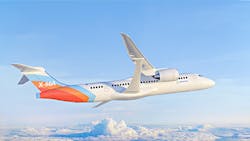This Could Be the Future Aircraft From Boeing and NASA
Southwest Airlines and American Airlines will give their input on a new flight demonstrator project and the development of a new research aircraft, as part of a collaboration between Boeing and NASA.
Southwest and American are among two of five major U.S. airlines to participate by giving their thoughts on operational efficiencies, maintenance, handling characteristics and airport compatibility. The airlines will discuss the X-66A research aircraft, designated by the U.S. Air Force.
“Hearing directly from the operators during all phases of the Sustainable Flight Demonstrator project will help us understand exact requirements and tradeoffs,” said Todd Citron, chief technology officer at Boeing in a release. “The airlines’ feedback will significantly contribute to the X-66A project learnings while furthering aviation sustainability.”
Hype for a next-generation aircraft has been on hold with both Boeing and European rival Airbus as the companies cash in on older generation aircraft, or variations such as the 737 Max and A321neo. The simple dual-engine jet design of most of the country’s commercial airliners has been the standard for decades and neither airline has released an entirely new model for nearly two decades.
Much of that is because aerospace and airline companies are waiting on the development of planes capable of running on alternative fuels such as hydrogen or electricity, or for new engine designs that can save money and leave a friendlier environmental footprint. Boeing CEO Dennis Calhoun has said he doesn’t expect a new model launched this decade.
The Sustainable Flight Demonstrator Project is part of NASA’s Integrated Aviation Systems Program, which works with industry leaders, academia and other government organizations to identify technologies that have a chance at being the next generation single-aisle seat class airliner. The centerpiece of the project is the experimental airplane that the program will develop, notionally planned to fly in 2028.
The aircraft is testing the Transonic Truss-Braced Wing airframe configuration, an ultra-thin and aerodynamic wing design supported by diagonal trusses, according to Simple Flying. It will be built from a modified MD-90 aircraft, known for its extensive use by Delta Air Lines, at a Boeing facility in Palmdale, California.
The Transonic Truss-Braced Wing was brought up during Boeing’s latest earnings call.
“We’re heavily invested in this,” Calhoun said. “We like what it could potentially deliver to this market, a level of performance that the industry is used to seeing with brand new programs.”
It’s NASA’s first X-plane, an experimental plane, focused on achieving a goal of net-zero aviation greenhouse gas emissions. The new technology could reduce fuel consumption and emissions by up to 30% in today’s domestic fleet of aircraft.
Southwest, American, Alaska Airlines, Delta and United Airlines will all provide feedback on design, simulation and lab testing and flight testing. Flight testing is scheduled for 2028 and 2029 out of NASA’s Armstrong Flight Research Center at the Edwards Air Force Base in California.
©2023 The Dallas Morning News. Distributed by Tribune Content Agency, LLC.
